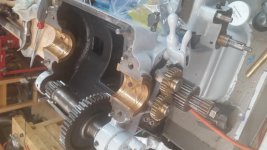Not my SB- 11" Sheldon but the same rules apply (just acquired).
Bronze spindle bearings, and spindle were in excellent condition upon disassembly and inspection (surprisingly so, looked new).
Replaced reservoir wicks after cleaning up the headstock and then dropped the bearing caps on. Manual says to torque to feel, as it was before assembly.
I thought it odd at disassembly that it took so little torque to loosen the cap screws, just kind of "twisted on" torque. On reassembly, I torqued them "snug" to start- and couldn't turn the spindle by hand. The screws on the front bearing in particular needed to be tightened just a few degrees beyond contact- any more and the spindle would bind.
My concern is that with so little torque on them one or more will just vibrate completely loose and cause problems without me being aware of it. Is it odd to have such tight bearings? I was thinking of dropping some Loctite 290 down into the threads?
Bronze spindle bearings, and spindle were in excellent condition upon disassembly and inspection (surprisingly so, looked new).
Replaced reservoir wicks after cleaning up the headstock and then dropped the bearing caps on. Manual says to torque to feel, as it was before assembly.
I thought it odd at disassembly that it took so little torque to loosen the cap screws, just kind of "twisted on" torque. On reassembly, I torqued them "snug" to start- and couldn't turn the spindle by hand. The screws on the front bearing in particular needed to be tightened just a few degrees beyond contact- any more and the spindle would bind.
My concern is that with so little torque on them one or more will just vibrate completely loose and cause problems without me being aware of it. Is it odd to have such tight bearings? I was thinking of dropping some Loctite 290 down into the threads?


 here is what I was thinking of-
here is what I was thinking of-
